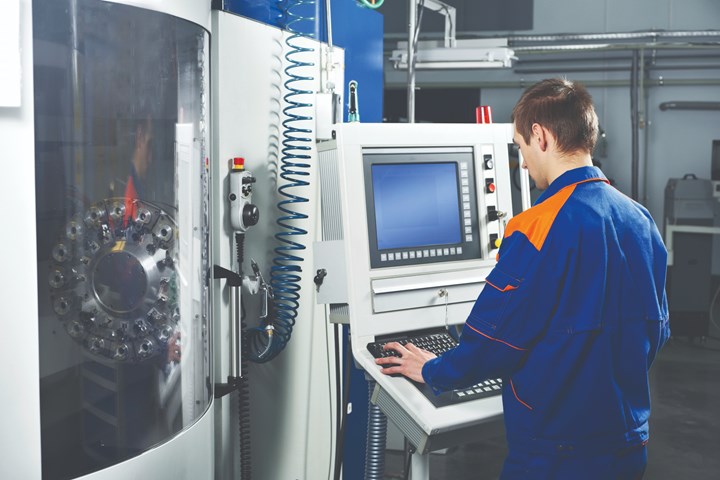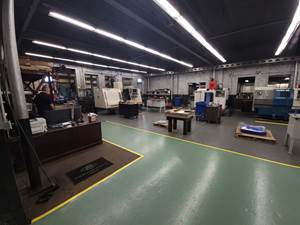Understanding CNC Machine Accuracy and Repeatability
Properly evaluating machine tool capability requires understanding how the both user and the builder can influence precision.

I define a CNC machine tool’s accuracy as how precisely its axes can follow intended paths to commanded endpoints while under load. I define its repeatability as how precisely it can duplicate commanded motions (again, under load) during multiple cycles throughout the day.
These are definitions for dynamic accuracy and repeatability. They likely vary from your machine builder’s specifications. Builder specifications commonly indicate static accuracy and repeatability; that is, the machine is not in cycle performing machining operations when related measurements are taken.
In fairness to machine builders, dynamic accuracy and repeatability vary with the amount of stress exerted on machine components. The greater the stress, the more difficult it is to maintain accuracy and repeatability. This makes it impossible for machine builders to provide, much less guarantee, dynamic accuracy and repeatability specifications. There are simply too many variables.
That said, machine builders should be able to establish whether their machine can achieve accuracy/repeatability requirements for your particular application. They should be willing to guarantee as much if you ask them to do so prior to purchasing a new machine tool.
Certain accuracy-related factors are beyond a CNC user’s control once a machine is installed. These include:
The machine’s construction
• It must be able to perform the most powerful machining operations in your application without excessive deflection of its support components.
The feedback system
• Linear scales directly monitor the position of the moving component for an axis. Unlike rotary encoders, they are not highly dependent upon the integrity of axis system components (way systems, ballscrews and couplers).
Other accuracy-related factors are the responsibility of the machine user. These include:
Machine tool calibration
• Machine builders initially calibrate pitch error and backlash compensations, but if accuracy is to be maintained, end users must repeat these calibrations at regular intervals during a machine’s life.
Environment
• Machine tools must be placed in a stable working environment that minimizes ambient temperature and humidity variations.
Ensuring that a machine installation can provide adequate dynamic accuracy for your application—and keeping it properly maintained—is but half the issue of producing consistent, acceptable components. You must also confirm that the machine can accurately repeat from the first workpiece to the last—hour after hour, day after day—even as machine components warm up after idle periods.
An important repeatability-related issue linked to machine design is thermal variation of moving components. Primary concerns are the machine’s spindle and way systems because they have the biggest impact on machined surfaces. As these components warm, they grow. As they cool, they shrink. This makes it difficult—maybe impossible—to hold size on critical, tight-tolerance surfaces during the machine warm-up period.
Machine builders go to great lengths to minimize thermal changes in machine components (cooling the spindle and/or way systems, for instance). Additionally, they incorporate design methods that minimize the repeatability impact of thermal variation. With CNC turning centers, for example, the headstock may be perpendicular to the bed. As it warms, only the height of the cutting tool’s edge changes. This minimizes the amount of machined diameter variation from part to part as the machine warms up.
When purchasing any new CNC machine, you should understand how the builder deals with thermal variation. More importantly, you must confirm that machined-surface variations caused by thermal growth during warm-up will not exceed tolerances. Otherwise, you could be in for a productivity-wasting surprise when you discover that your new machine must run for a warm-up period before it can be used in production.
Some of the most severe repeatability issues have nothing to do with machine design. Instead, they are influenced by the machine’s application. Variations of any kind—during a production run or from one time a job is run to the next—can impact repeatability. Things that change from cycle to cycle will cause the need for a time-consuming adjustment. If the variation is great enough, it could result in scrap.
What are examples of variations?
Examples of variations during a production run include:
• Tool wear. As cutting edges wear, machined surfaces will vary. External surfaces grow while internal surfaces shrink.
• Dull tool replacement. When dull cutting tools are replaced, extreme caution is required to ensure that cutting edge(s) do not vary from their predetermined position(s).
From one time a job is run to the next include:
• Workholding setup. Many factors affect workpiece stability (placement/alignment of the workholding device, clamp location and force applied, and program zero assignment, for instance).
• Cutting tool assembly, measurement and offset entry. Component and assembly variations result in rigidity variations that can lead to machining issues.
• Machine condition. Variations caused by mishaps and the neglect of preventive maintenance can result in sizing problems with jobs that have run successfully in the past.
Related Content
6 Machine Shop Essentials to Stay Competitive
If you want to streamline production and be competitive in the industry, you will need far more than a standard three-axis CNC mill or two-axis CNC lathe and a few measuring tools.
Read MoreKey CNC Concept No. 1—The Fundamentals Of Computer Numerical Control
Though the thrust of this presentation is to teach you CNC usage, it helps to understand why these sophisticated machines are so important. Here are but a few of the more important benefits offered by CNC equipment.
Read More6 Steps to Take Before Creating a CNC Program
Any time saved by skipping preparation for programming can be easily lost when the program makes it to the machine. Follow these steps to ensure success.
Read MoreFrom Tradition to Transformation: Century-Old Manual Machine Shop Adds CNCs
After 122 years of working with manual mills and lathes, this fifth-generation shop acquired assets of a local CNC machining business and hired the owner. Here’s how it’s going a year later.
Read MoreRead Next
The Cut Scene: The Finer Details of Large-Format Machining
Small details and features can have an outsized impact on large parts, such as Barbco’s collapsible utility drill head.
Read More3 Mistakes That Cause CNC Programs to Fail
Despite enhancements to manufacturing technology, there are still issues today that can cause programs to fail. These failures can cause lost time, scrapped parts, damaged machines and even injured operators.
Read More
.jpg;width=70;height=70;mode=crop)











.png;maxWidth=300;quality=90)













